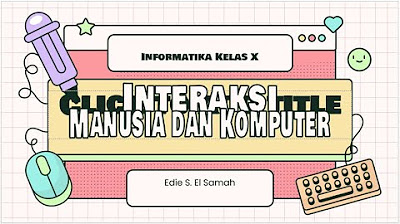Mastering Control Interfaces: From Input Methods to Robotic Locomotion
Summary
TLDRThis video explores the core components of control interfaces, examining how input methods like buttons, touchscreens, and knobs allow us to interact with technology. It discusses the vital role of output displays in providing feedback through visual and audio cues, ensuring smooth communication between users and systems. The script also covers status indicators, such as battery and Wi-Fi icons, which keep users informed with real-time updates. Finally, it highlights actuators, the 'muscles' that turn signals into physical actions, completing the cycle of interaction. Understanding these elements deepens our appreciation for the technology we use daily.
Takeaways
- 😀 Input methods are the bridge between human intention and machine action, making technology accessible and functional.
- 😀 Buttons are a familiar and effective input method, offering a tactile, simple way to interact with devices.
- 😀 Knobs and dials provide more precise control over parameters like volume or temperature, allowing for fine adjustments.
- 😀 Touchscreens have revolutionized user interaction by enabling intuitive, direct manipulation of content through swiping, tapping, and pinching.
- 😀 Software interfaces, such as menus and sliders, offer a flexible way to interact with complex systems, providing versatility.
- 😀 Output displays, including visual and audio feedback, ensure users know the system has received their input and is processing it.
- 😀 Visual feedback, like screen displays and LED indicators, provides real-time status updates about the system's condition.
- 😀 Audio feedback, such as beeps or notification sounds, grabs attention quickly, especially in situations where visual attention might be diverted.
- 😀 Status indicators, including color-coded icons and audio cues, keep users informed of the system's state and help with quick decision-making.
- 😀 Actuators convert energy into mechanical motion, turning signals from input methods into real-world actions, making them the 'muscles' of control systems.
- 😀 Electric motors, pneumatic actuators, hydraulic actuators, and mechanical actuators all play critical roles in translating commands into physical motion.
Q & A
What is the role of input methods in control interfaces?
-Input methods are the tools or mechanisms that allow users to communicate their intentions to a system. These include buttons, touchscreens, knobs, and virtual menus, all of which serve as the interface between human actions and machine responses.
How do buttons function as an input method?
-Buttons work by closing a circuit when pressed, which sends a signal to the system to perform an action. Despite being an older technology, buttons remain widely used because of their simple, tactile, and immediate feedback.
What are the advantages of using knobs and dials as input methods?
-Knobs and dials offer users more control over parameters that require fine adjustments, such as volume or temperature. These input methods are particularly effective for settings that require precise and gradual changes.
How have touchscreens transformed user interactions with devices?
-Touchscreens have revolutionized user interactions by enabling direct, intuitive engagement with content. Actions like swiping, tapping, and pinching allow users to manipulate the interface with a natural and fluid gesture, providing a more interactive experience.
What role do software interfaces like menus and sliders play in user interaction?
-Software interfaces like menus, sliders, and virtual buttons allow for versatile interaction with complex systems. They simplify navigation and provide users with intuitive controls for managing settings or performing actions within software.
What is the importance of output displays in control systems?
-Output displays are essential for providing feedback to users, confirming that their input has been received and processed. These displays, whether visual (like screens) or auditory (like sounds), ensure that users are informed about the system’s status.
Why are visual feedback cues important in control interfaces?
-Visual feedback cues, such as lights or screens, are crucial for showing users real-time information about the system’s status. For instance, a phone display may show notifications, while an LED indicator light can signal if a device is on or in standby mode.
How does audio feedback complement visual feedback in control systems?
-Audio feedback provides immediate, attention-grabbing alerts, especially in situations where visual feedback may not be readily noticed. Sounds like beeps, chimes, or alarms ensure users don't miss critical updates or warnings.
What are status indicators, and why are they important in everyday technology?
-Status indicators are small, often visual elements, like battery icons or Wi-Fi symbols, that provide real-time updates on a system's state. These indicators help users stay informed and make quick decisions based on the system’s condition.
What are actuators, and how do they function in control interfaces?
-Actuators are components that convert signals from the control system into mechanical actions. These can include electric motors, pneumatic systems, hydraulic systems, or mechanical levers, all of which allow the system to perform physical tasks based on user inputs.
Outlines

此内容仅限付费用户访问。 请升级后访问。
立即升级Mindmap

此内容仅限付费用户访问。 请升级后访问。
立即升级Keywords

此内容仅限付费用户访问。 请升级后访问。
立即升级Highlights

此内容仅限付费用户访问。 请升级后访问。
立即升级Transcripts

此内容仅限付费用户访问。 请升级后访问。
立即升级5.0 / 5 (0 votes)






